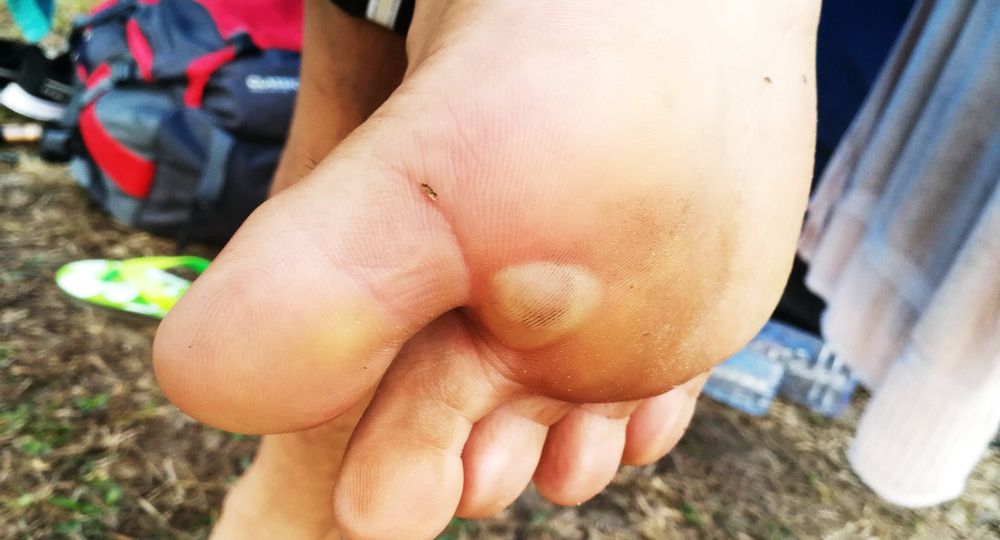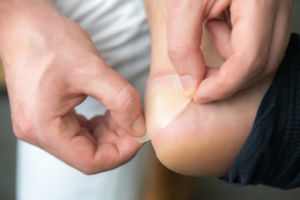
It’s not uncommon for someone to spend extra time walking throughout the day to come home and realize there’s a blister under a foot. Hiking, running, walking, cycling, and other sports can all cause blister development. A painful blister can be caused by many things and make it hard to exercise, walk, or even stand for long periods.
What Is a Blister Under the Foot?
Before we dig into how to prevent and treat blood blisters, let’s look at what blisters on the hands and feet are. A blister is a small pocket on the skin that is filled with some type of fluid. They can occur due to trauma, insect bites, infections, or skin burns. These fluid-filled bumps can make it hard to participate in daily activities.
If you have a friction blister on your feet, it can be painful and frustrating as you need to change the way you do things. However, there are several home remedies you can use to help with the discomfort and lessen the chances you get another blister.
What Causes a Blister on the Feet?
One of the most common causes of blisters on the feet is friction. When you stand or walk for several hours, this creates pressure on the toes, soles, and heels. The longer you spend on your feet, the more likely the top layer of skin will develop blisters.
However, this isn’t the only cause of foot blisters. If you wear poorly fitted shoes, this can also cause blisters. If your shoes fit too tightly or too loosely, they can rub up against your skin. This causes friction and fluid may build up under the top layer of skin.
Other things that can cause blisters include excessive perspiration or moisture on the feet. This is common among athletes in warm months, especially runners. Small blisters may be seen when sweat clogs the pores of the feet.
Sunburn can also lead to blisters. In addition, below are a few causes of blisters on the feet:
- Allergic reactions
- Bacterial infections
- Chemical exposure from detergents or cosmetics
- Chickenpox
- Dyshidrotic eczema
- Frostbite
- Fungal infections
- Herpes
How to Treat a Blister Under the Foot
 Most of the time, if you leave a foot blister alone, that is enough treatment for it to clear up. Even basic care can help treat a blister. It’s best to keep both blood blisters and friction blisters intact. While they may be painful, they are also a way of naturally defending the body. They protect underlying tissues and reduce pressure.
Most of the time, if you leave a foot blister alone, that is enough treatment for it to clear up. Even basic care can help treat a blister. It’s best to keep both blood blisters and friction blisters intact. While they may be painful, they are also a way of naturally defending the body. They protect underlying tissues and reduce pressure.
In addition, blisters seal off the tissues to prevent fungus, viruses, or bacteria from entering the wound.
If you know you have a blister, it’s important to avoid putting more pressure on it. For blisters that are broken and have drained, the best thing to do is wash your hands and clean the area around the blister with water and soap. Next, cover the blister with a loose bandage or gauze.
Those who have an allergy or chemical blister should remove the irritant and wash the skin thoroughly.
A few other options for home treatment include the following:
- Apply an ice pack wrapped in a towel to the blister without pressure.
- Use a blister bandage to cover the area.
- Raise the foot with a pillow or chair to reduce blood flow and limit inflammation.
- Keep the area dry to aid the healing process.
- Remove socks or shoes that created the blister.
- Apply petroleum jelly or antibiotic cream to the blister and the area surrounding it.
- Clean the skin using over-the-counter solutions for pain and inflammation, such as apple cider vinegar or hydrogen peroxide.
Once the blister opens, you should use sterilized tweezers or scissors to remove any dead skin. Make sure to be gentle and avoid removing healthy tissue.
When to Visit a Physician for a Blister Under the Foot
There are certain situations where you need to see a podiatrist due to blisters on the feet. If the blister worsens, becomes inflamed, looks discolored, or doesn’t heal in a few days, you should get in touch with a medical professional.
If a blister is purple, green, or yellow, it has become injected and needs attention. In some cases, blisters of an abnormal color can indicate some kind of health condition, such as herpes.
For extremely disabling, persistent, or infected blisters, podiatrists may choose to drain them in the office. A sterilized needle or scalpel will be used. A small sample may be taken for testing needs.
In many cases, oral or topical antibiotics will be provided to prevent additional infection in the body.
The Answer to Preventing Blisters on the Feet
The majority of blisters on the feet come from a combination of pressure and rubbing. However, other factors make it more likely you will experience these blisters.
Heat, moisture, and pressure can all wear on the skin and make it more likely to tear. Badly fitting socks and shoes can also create raw skin where they contact the feet.
On the other hand, there are several prevention methods for a blister under the foot. The first is to apply talcum powder or foot tape and moleskin before doing activities that could lead to blisters.
You can also find bandages with empty holes to cushion the feet and reduce friction. Wear moisture-wicking socks to avoid excess moisture and keep the feet dry. Sole inserts with padding are also a great way to reduce pressure.
Final Thoughts
Follow the steps above and avoid risk factors to prevent blisters on the feet. If a blister does occur, the best way to heal it is by protecting it and letting it repair itself. However, if the blister changes color, gets worse, or doesn’t seem to be healing, a podiatrist can give you advice on how to move forward. It is always good to see medical advice for your local chiropodist at a podiatric clinic near you.
We are located in South East and West Florida, with foot clinics in Boca Raton, Coral Springs, West Palm Beach, Lake Worth, Pembroke Pines, Cape Coral, Brandon and St. Petersburg. For a complete list please visit our locations page.
Frequently Asked Questions
1. What causes blisters under the foot, especially in Florida’s hot weather?
Blisters often happen from friction — like when your foot rubs against your shoe while walking, running, or cycling. Here in Florida, our heat and humidity add to the problem by making your feet sweat more, increasing the chances of irritation and blistering.
2. Should I pop a blister under my foot if it’s bothering me?
Nope! It’s best to leave a blister alone if you can. It’s your body’s natural way of protecting the area. If it breaks on its own, clean it gently with soap and water, cover it with a loose bandage, and keep it dry to avoid infection — especially important in our humid Florida climate.
3. How can I treat a painful foot blister at home?
Start by keeping weight off the blister as much as possible. Use a blister bandage, apply an ice pack (wrapped in a towel) to reduce swelling, and keep the area clean and dry. A little petroleum jelly can help protect the skin while it heals. Don’t forget to kick off those sweaty socks and sandals when you get home!
4. When should I see a podiatrist for a blister?
If the blister looks purple, green, or yellow, feels very painful, or isn’t healing after a few days, it’s time to call a doctor. Florida’s warm, damp environment can sometimes make infections worse, so don’t wait if something seems off.
5. How can I prevent getting blisters while enjoying outdoor activities in Florida?
Pick well-fitted shoes and moisture-wicking socks, especially if you’re hitting the beach, parks, or trails. Using talcum powder, foot tape, or moleskin on high-friction areas can help too. And remember — dry feet are happy feet, so swap out wet socks as soon as possible!